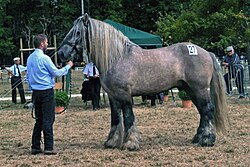Poitevin (horse)
| Poitevin (horse) | |
|---|---|

|
|
| Important data | |
| Origin: | Poitou |
| Main breeding area: | France |
| Distribution: | France |
| Stick measure : | 160 cm - 175 cm |
| Colors : | all colors are allowed except piebald, mostly dun |
| Main application area: | Mule breeding, riding horse, driving horse, agriculture |
The Poitevin mulassier , also called Poitevin or simply Mulassier , is a French cold-blooded horse breed . It owes the name Mulassier to its most important original function, namely the breeding of mules (French: le mulet and la mule ), which are valued for their strength and endurance. The name Poitevin is derived from the region where it originated, the Poitou . The number of Poitevins has decreased significantly with motorization and today this breed of horse is threatened with extinction.
Background information on horse evaluation and breeding can be found under: Exterior , interior and horse breeding .
Exterior
- The Poitevin is an elegant cold blood that is very durable and capable of working for over 20 years.
- The simple head is large, heavy and has a ramsnose with wide gaiters, the nostrils are wide and the ears are strong and somewhat immobile.
- The neck is quite long, strong and runs into a strong, steep shoulder that is not lacking in strength. The chest is wide and deep.
- The trunk is long and large, and the ribs are flat.
- The withers are not very pronounced and run in a long, straight and strong back.
- The croup is slightly knocked off, the hips are broad and protruding and the tail is set low.
- The limbs are strong and covered with lush, curly hangings. The hind legs are stable and strong, and the overall proportions are good.
- The large plate hooves are hard and flat, as is typical of old European bog cold blood breeds.
- The average height is between 1.60 m and 1.75 m.
Coat colors
Most mulassians are Fallows with eel lines and zebra stripes on their legs, in all shades. There are gray, brown, mouse, and red falcons. But all other basic colors (foxes, blacks, browns and molds) are also represented, albeit in small numbers. The Poitevin is one of the few horse breeds that also produces Isabelles. Some of them have burin hair; other badges are rather untypical. All colors except piebald are allowed.
interior
The Poitevin is a willing, honest and gentle horse with a calm character who values human contact and is therefore an ideal companion for riders, coachmen and agricultural use. At work, it shows great intelligence. Even if it can be stubborn at times, it is very attentive and energetic. His weak point is tedious work, as he lacks stamina, which can be made up for by working regularly.
Breeding history
In 1599, King Heinrich IV commissioned Dutch engineers to drain the marshland. They brought their horses, Frisians and Belgian draft horses, and crossed them with local mares. The so-called Poitiers comes from this crossing. The Poitiers mares were eventually used by crossing with Poitou donkeys to breed a large, rustic breed of mules. The studbook for the Poitevin was established in 1884. It includes both horses and donkeys. In 1922 it was closed after the admission of 424 stallions in order to enable pure breeding based on the coat color and the work performance of the horses.
A joint study with the INRA sees the breed as critically endangered. In order to preserve the maximum genetic diversity of French farm animal breeds, high priority is given to the preservation of the Poitevins breed. A genetic investigation from 1994 revealed that the entire Mulassier population has a common ancestor (father, grandfather, great-grandfather), the stallion Quebec, born in 1960. This creates a significant risk of inbreeding. Since then, a backup plan to regain genetic variability has been implemented by the UPRA . The Mulassier birthrate has recently increased again, but the Poitevin is still an endangered breed of horse.
Areas of application
Originally used for breeding mules, the poitevin is now often used as a carriage horse when elegance and strength are required, and under the saddle for its calm and safe manner. It is versatile and can be used for pulling and agricultural work (e.g. for backing wood) as well as in hippotherapy. For the past 40 years, meat production has been one of the few economic reasons that have contributed to the continuation of the breed.
See also
Web links
- private page: entry into horse breeds in the world
- private side to the Poitevin
